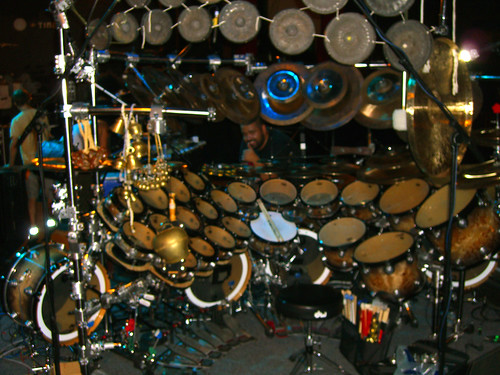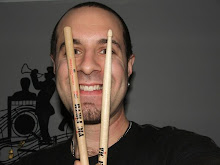Her name is Penny Larson (check her out here). She had a great feel, excellent dynamics, and her musical interpretation of Brian's songs was tasteful and supportive. But aside from all that, the most obvious thing about her playing was that she was standing.
Aside from the occasional percussionist, it's rare to see a "drumset" player stand consistently while playing her instrument. Sure, there are times when drummers may stand temporarily in times of extreme emotional expression during a solo or song ending (I do this occasionally). But to stand during the entire gig?
Very cool to watch indeed.
Penny's set was configured to comfortably accommodate her choice to remain standing throughout the night. Her cymbals and snare were mounted high. Her kick was up close so she didn't have to lean into it and alter her posture. She seemed relaxed and comfortable and her execution exemplified this.
I was reminded of the old school 'cocktail' kits:

http://en.wikipedia.org/wiki/Cocktail_drum
I still fantasize about owning one someday and playing a metal gig on it.
Anyways, watching Penny play inspired me to consider proper posture for playing the drumset. In my conversations with students and fellow peers, it seems a lot of drummers overlook this. Over the years I have done lots of experimentation with posture and I have come to some simple conclusions.
Seat Height
First off, ask yourself the following questions:
1. Do I ever experience lower back pain?
2. Do I ever experience tension and/or pain in my pelvic areas (the front of your hips/pelvis)?
3. Do I ever suffer from leg or foot fatigue?
If the answer is yes to any of these, seat height is the first thing to consider. I know many drummers who have bad backs and they have to be very careful with how they sit. Experimentation is required; there's no right or wrong height as it depends on your physiology.
One thing I try to notice is the angle of my legs while I'm sitting at my drumkit with my feet on the pedals. I try to get it as close to 90 degrees as possible. If seated too high, your legs are overly extended to reach the pedals and this defeats the purpose of utilizing gravity to provide some assistance in generating power. On the other hand if you sit too low you will be using more energy to raise your legs when working the pedals.
This is assuming 'heels-up' technique (i.e. heels are off of the pedals). If using 'heels-down' technique (i.e. heels on pedals), the angle of your legs is just as important since the ankle joints are doing all the work. If sitting too high, your feet are over-extended and the range of motion for your ankles is limited. Sitting too low angles your feet up and more movement is needed to work the pedals requiring more energy.
Throne Design
There's a plethora of throne designs these days. It may be worth your time to experiment with some of them if you're still using the good old "round stool" model.
First thing: thrones that have a back rest.

This essentially turns the throne into a chair which is why I personally avoid them. When sitting in a chair it allows one to lean back and utilize 'lazy' posture as the core muscles (i.e. your abs) aren't engaged to stabilize the body. As a result, the shoulders droop over and the back follows an irregular arc. When playing a drumset for long periods of time, poor posture will cause you back problems. I always strive to hold my back straight and my shoulders back. Think about how you would sit in a job interview...hopefully you're sitting up straight, not leaning back in the chair and slouching. Now translate that into your posture behind the drumkit.
Another thing to consider is cushion shape. I prefer a bicycle-style seat as I used to suffer from pelvic discomfort and changing to a bicycle-style throne really helped:

Other people (namely Steve Gadd) prefer the square 'piano bench' style throne:

If you are still using the standard round cushion, I suggest you pay a visit to your local music store and sit on some of the newer designs. You never know...it might help that nagging back spasm you've been dealing with for years!
Foot Placement
Up until recently I never considered the placement of my kick drum and hi-hat with regard to my legs. As long as my arm reach felt comfortable, I was happy. Then I started to get leg fatigue as well as odd cramps throughout my body, and my drumset configuration approach changed dramatically. Nowadays I find a happy medium between the distances that my arms and legs reach.
I notice a lot of drummers that place their kick far away from their bodies. This can cause leg fatigue because you'll be using more energy to generate power. As mentioned above, a good way to gauge appropriate location is the angle of your legs. If I sit in my throne before anything else is set-up, I find the proper height that forms my legs into a 90 degree angle. I note where on the floor my feet are resting. This is where my pedals will be located.
If my feet are pushed out away from my body and the angle of my legs is greater than 90 degrees, I lose leverage. Conversely, if they are pushed in close such that my feet are underneath my legs, I get hamstring cramps when playing fast patterns.
The distance that my legs spread out also makes a difference in my general body balance. I've noticed that if they are too far apart I depend more on my center of gravity for balance. Too close together and I feel 'wobbly'. The goal here is to feel balanced between your seat and your two feet.
Arm Placement
Don't forget about your arms!!
The farther you need to reach to get to everything, the more you're going to tend to lean into your kit, altering your center of gravity and throwing off your balance.
On the other hand, I find that if everything is real close, I can't use the full capacity of all the joints in my arm when generating power and volume. I also feel cramped.
Check out this video 'tour' of Vinnie Colaitua's kit. Notice how he's found a nice balance between locating everything close but not cramped:
Here's a picture of Terry Bozzio's monster kit. It's huge, but you can see how he's managed to (somehow) locate everything within reasonable distance:

Health
Did you ever stop to consider how much we rely on our bodies to perform our instrument? Think about it. We use all 4 limbs. How many times did you finish a song out of breath? How many gigs have you done that ended in a sweaty mess?
Our instrument is physical. Dare I say athletic. Doesn't it make sense then that the physical shape of our bodies affects our performance?
When I was a student at Berklee, I was an out-of-shape mess (as most college students are). I remember how little endurance I had. After I graduated, I started working out and running. Eventually I got into decent shape. The result? I can play for 5 hours or more and still have enough energy to hit the after party. More importantly though is that my balance is solid, so my technique is solid. This equates into less exertion which in turn results into precise execution.
I find regular cardiovascular exercise as well as core muscle training to be most relevant to increased drumset technique. Also, stretching and yoga has helped me feel more relaxed physically and mentally.
The bottom line is this: in addition to helping you lead a more enjoyable and health-conscious life, eating right and exercising regularly will help you become a better drummer.
Conclusion
We will only be able to perform at our best when we feel comfortable at our instrument, and we can control this through our choice of available equipment and a good awareness of body location. Whether we're standing up all night behind a tiny 'cocktail' style drumkit like Penny Larson or sitting behind a behemoth 100+ piece kit like Terry Bozzio, we need to experiment with all of the options at our disposal and be mindful of how our bodies feel when we play.
If you suffer from a nagging physical ailment, don't let it hold you back from finding your true potential on the drumset, or worse let it turn into a chronic condition that can threaten your career. Take the time to experiment. Take notes. Keep track of how your body responds to performances. Unlike most other musicians, we need our entire bodies to perform our instrument. Take care of it and your career will take care of you.

No comments:
Post a Comment